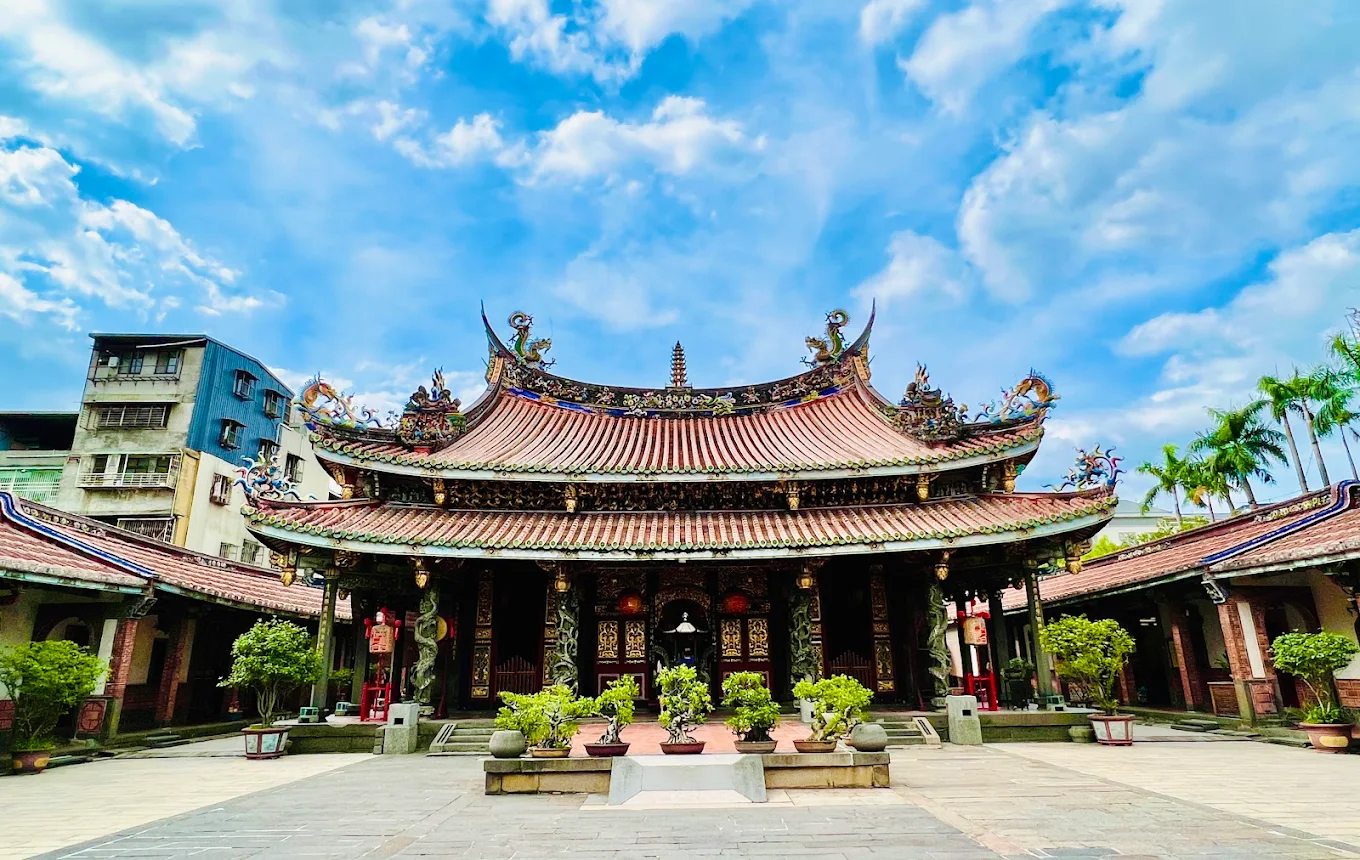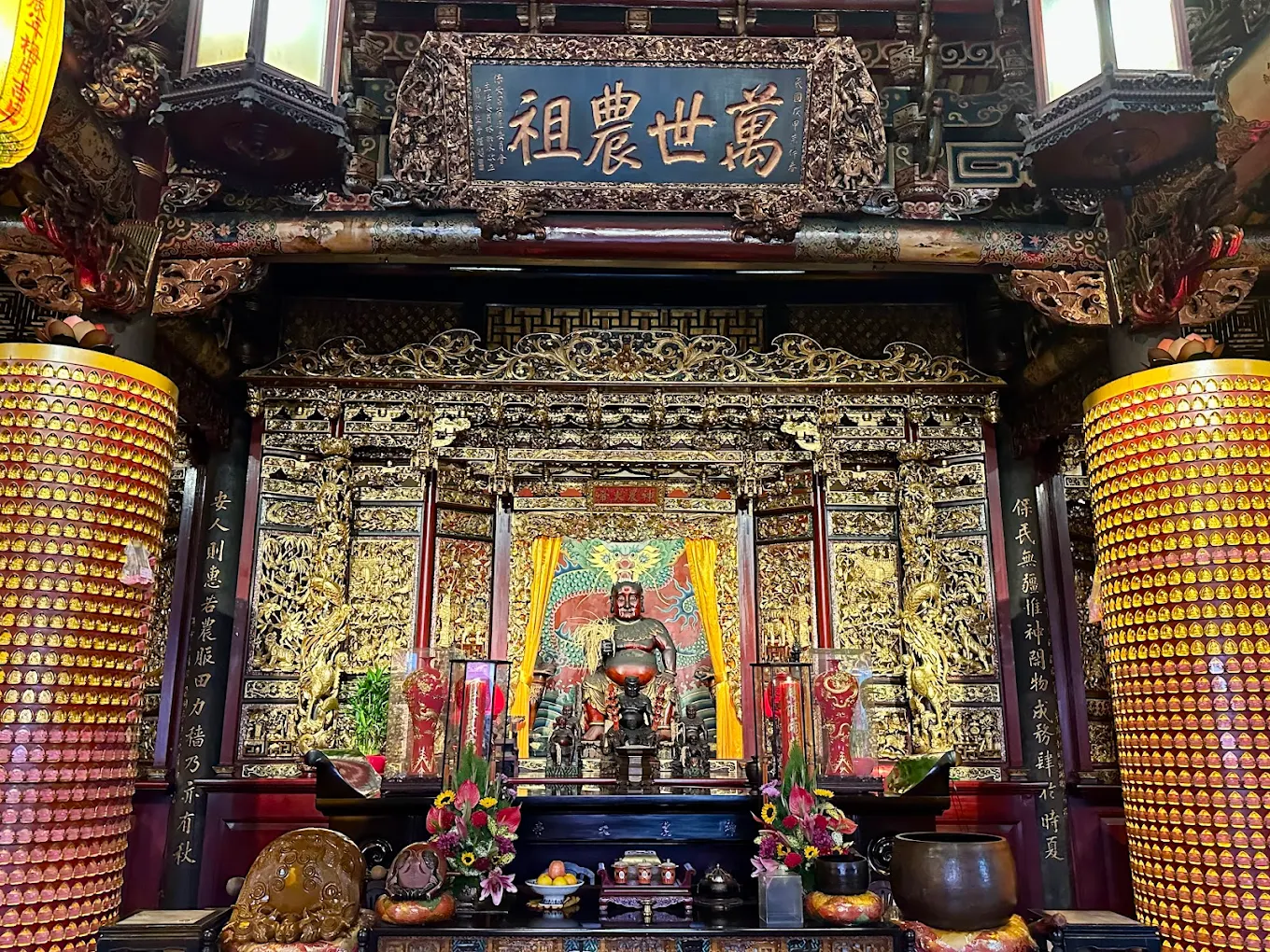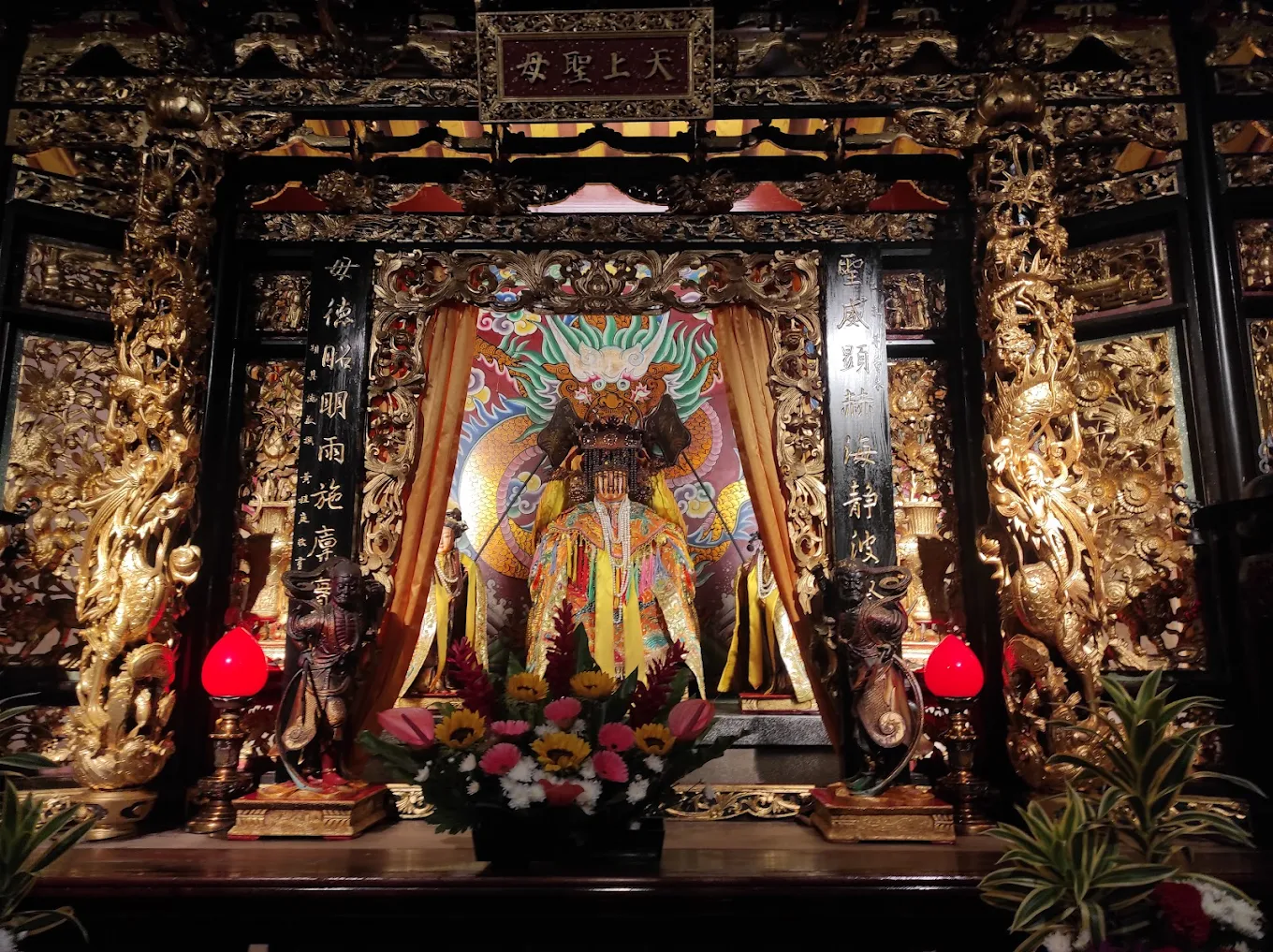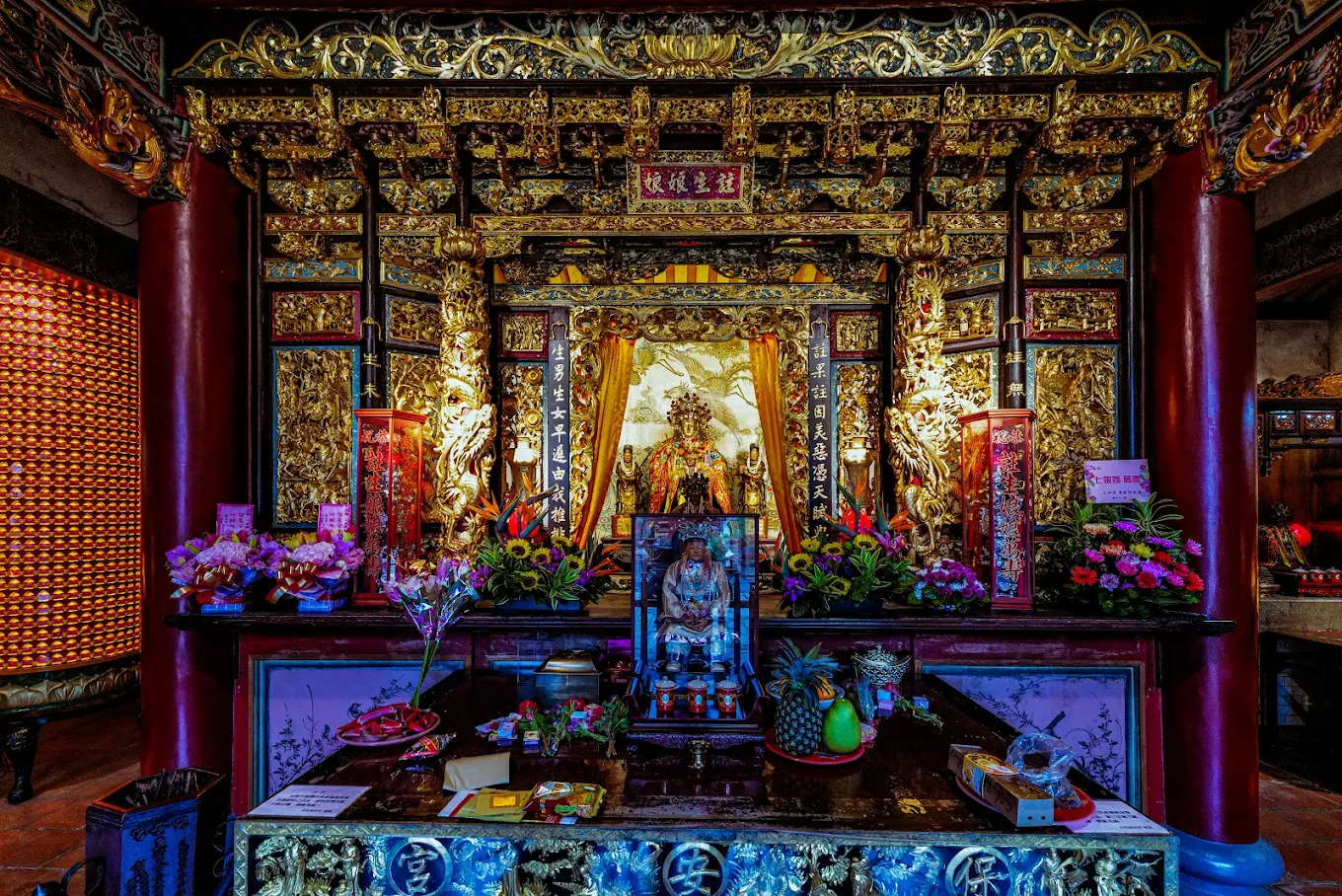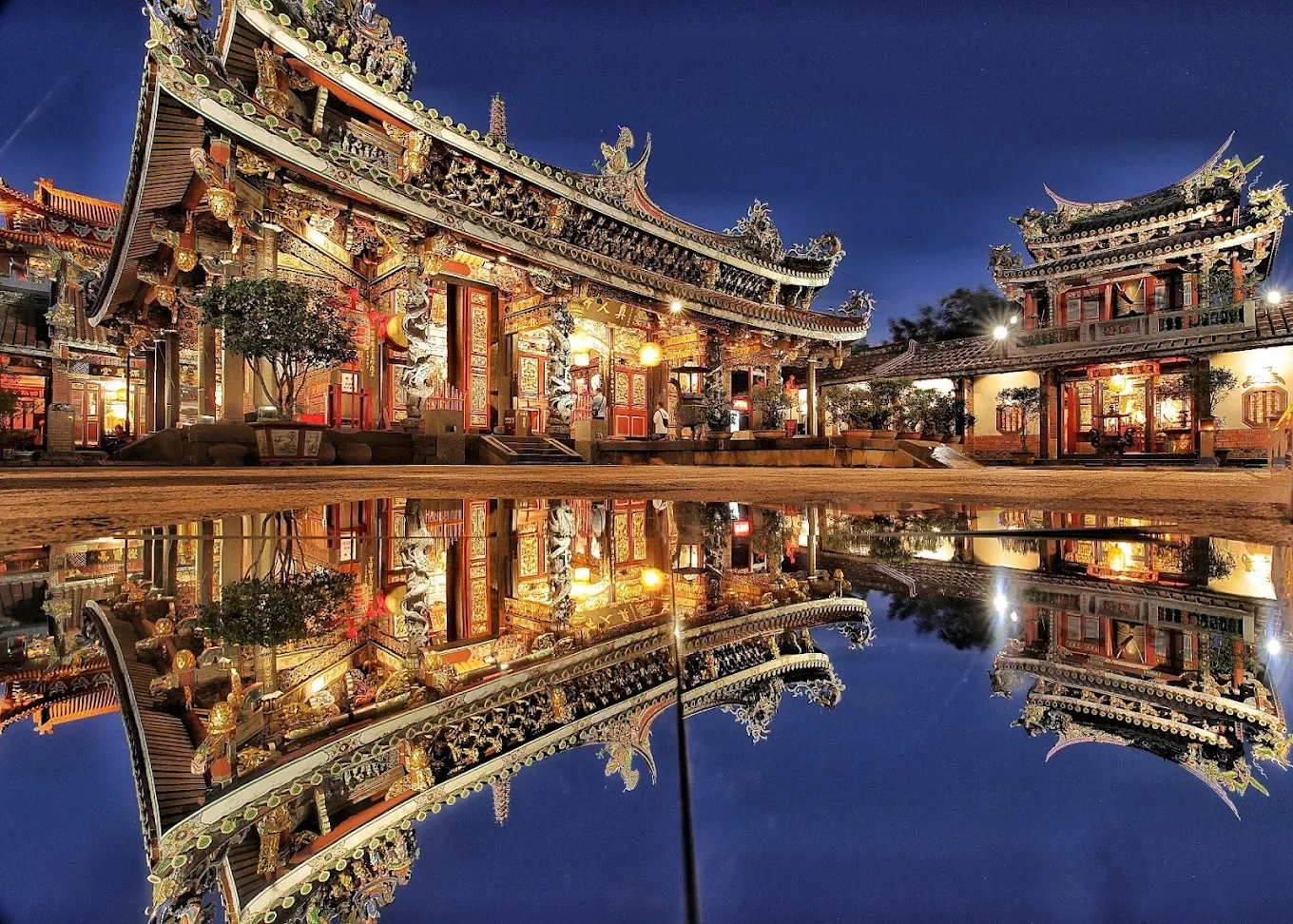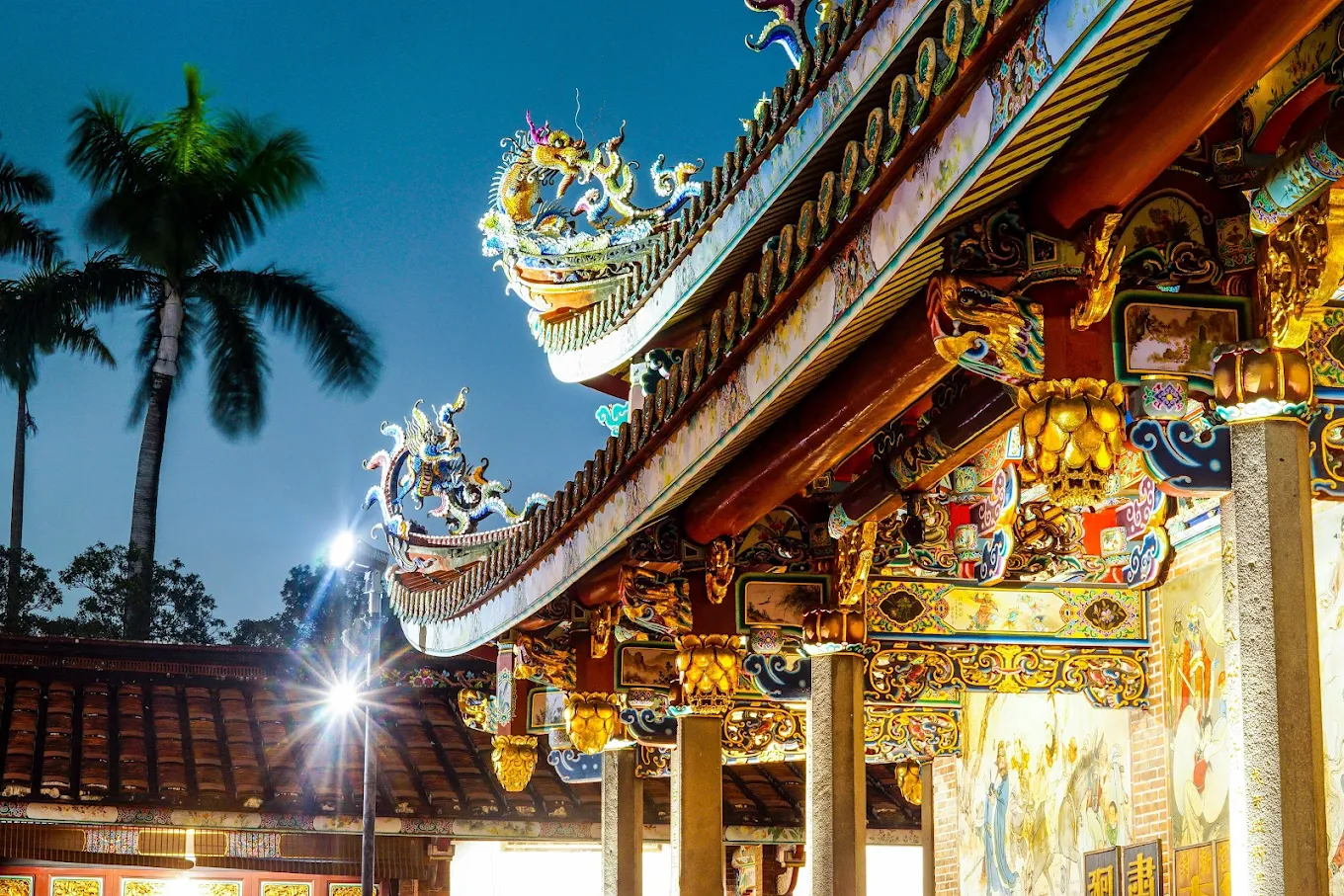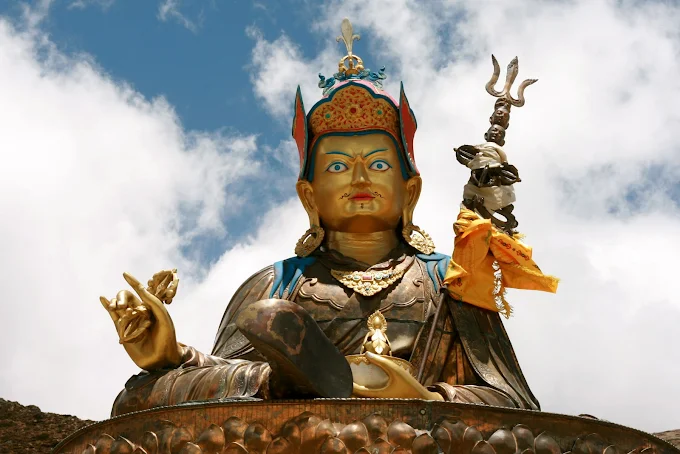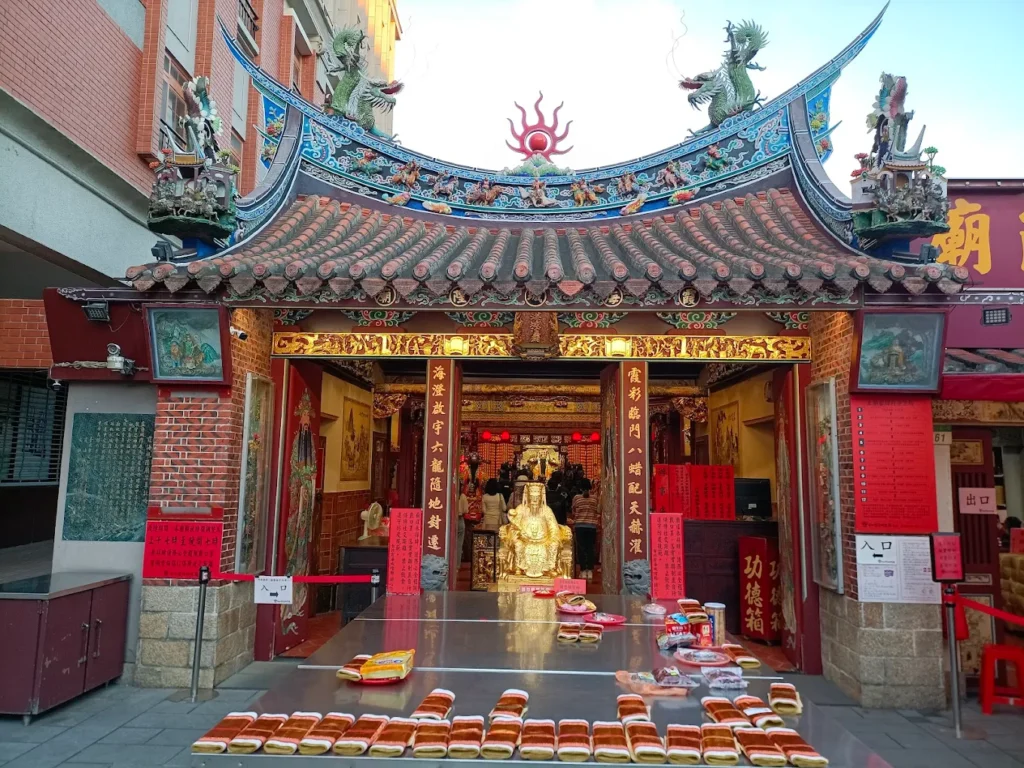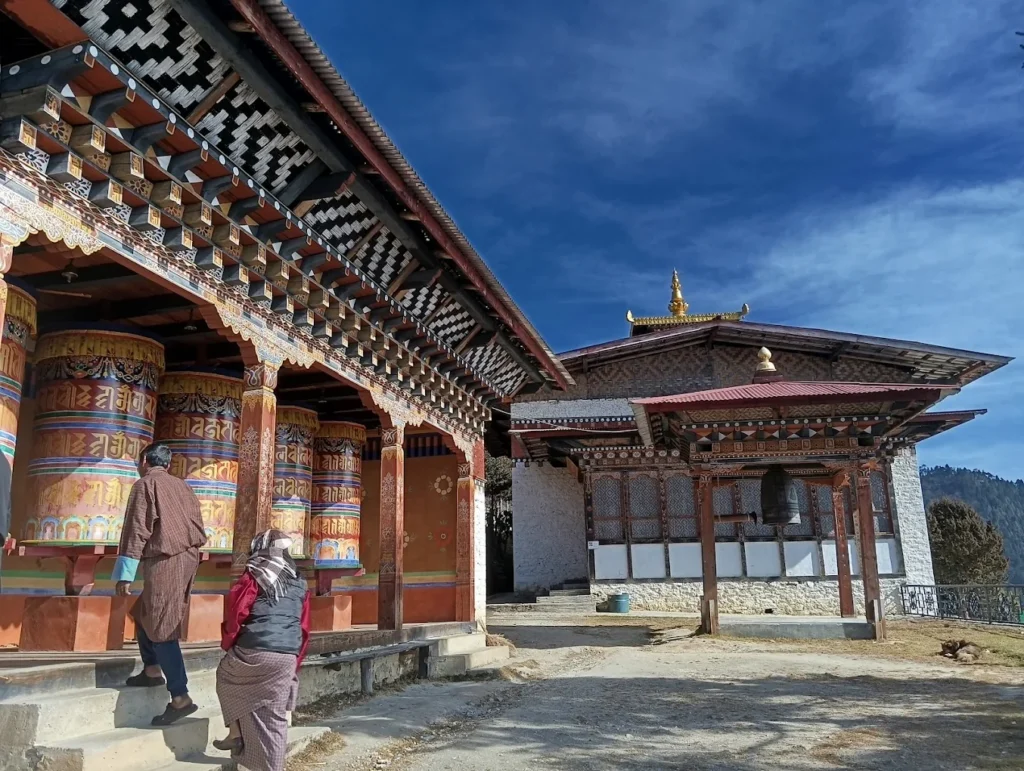Baoan Temple: The Fujianese Sanctuary of Healing in Taipei’s Datong District
In Taipei’s Datong District, the air carries the earthy scent of medicinal herbs and the soft clink of jiaobei [divination blocks] at Baoan Temple, a Fujianese haven founded in 1804. This Taiwanese folk temple, blending Buddhist, Taoist, and Confucian traditions, pulses with devotion to Baosheng Dadi [Bǎoshēng Dàdì], the Emperor of Medicine, revered for his healing powers. Baosheng Dadi, a deified physician from Song Dynasty Fujian, is believed to cure ailments and guide devotees to wellness, his 1.8-meter teak statue radiating benevolence in the main hall. The temple’s vibrant murals, depicting mythical phoenixes, glow under lantern light, distinct from Longshan Temple’s bronze dragon pillars. Devotees offer herbal bundles, their bitter aroma mingling with incense, seeking health and prosperity. Hosting over 50 deities, from Mazu to Wenchang Dijun, Baoan Temple draws worshippers and cultural travelers to its serene courtyard, where Taipei’s healing heritage unfolds amidst the bustle of Hami Street.
Overview and Significance
Introduction to Baoan Temple
Baoan Temple, nestled in Taipei’s vibrant Datong District, is a cornerstone of Taiwanese folk religion, weaving Buddhist compassion, Taoist harmony, and Confucian ethics into a cultural mosaic. Established in 1804 by Fujianese immigrants, it centers on Baosheng Dadi, the Emperor of Medicine, whose healing legacy defines its identity. Taiwanese folk religion, a syncretic faith, blends Buddhist selflessness, Taoist cosmic balance, and Confucian duty, creating a spiritual hub for health-seekers. The temple’s colorful murals, unlike Longshan Temple’s bronze pillars, depict mythical creatures, symbolizing renewal and protection. For cultural travelers, Baoan Temple offers a vivid window into Taipei’s Fujianese heritage and medicinal traditions.
Historical Journey
Founded by settlers from Tong’an, Fujian, Baoan Temple emerged as a spiritual refuge during Qing rule, when disease plagued early Taipei. Completed in 1830 after decades of communal effort, it survived an 1867 typhoon and Japanese occupation (1895–1945), during which it served as a community hospital. A 1918 renovation by architect Chen Ying-bin introduced vibrant murals, blending Fujianese and Western styles. Post-World War II, Baoan supported Taipei’s recovery, offering free herbal remedies. Its designation as a UNESCO Asia-Pacific Heritage Award recipient in 2003 underscores its historical significance, verified by temple records, making it a must-visit for history enthusiasts.
Cultural Significance
Baoan Temple anchors Datong’s identity, hosting festivals like Baosheng Dadi’s birthday on the 15th day of the third lunar month, where lion dances and herbal offerings fill the courtyard. The Zhongyuan Festival [Hungry Ghost Festival], a Taoist-Buddhist rite to honor wandering spirits, features communal feasts with sticky rice dumplings. Globally, it attracts Southeast Asian pilgrims seeking Baosheng Dadi’s healing blessings, fostering cross-cultural ties. Its role in community health initiatives, like free medical clinics, makes Baoan Temple a cultural beacon for travelers exploring Taipei’s heritage.
Unique Legacy
Baoan’s focus on Baosheng Dadi, the Emperor of Medicine, sets it apart from Longshan’s syncretic breadth or Xingtian’s commercial deity. Its murals, depicting phoenixes and dragons, symbolize healing and renewal, reflecting Fujianese artistry. Philosophically, the temple balances Taoist yin-yang with Buddhist compassion, offering travelers insights into Taiwan’s pluralistic faith. Its medicinal heritage, tied to Fujianese pharmacology, distinguishes Baoan Temple as a sanctuary of wellness in Taipei’s spiritual landscape.
Community and Global Impact
Baoan Temple unites Datong’s residents through rituals and charity, with locals gathering in Dalongdong Park post-worship. Its free herbal clinics and health workshops strengthen community bonds, while guided tours educate global visitors. Southeast Asian devotees, drawn to Baosheng Dadi, highlight its international reach. The temple’s role in Taiwan’s cultural preservation, recognized by UNESCO, invites travelers to witness Datong’s communal vitality.
Historical Anecdotes
A 19th-century tale recounts a merchant cured of fever after praying to Baosheng Dadi, dedicating a jade tablet now in the main hall. Another story describes Chen Ying-bin’s 1918 mural designs, inspired by Fujianese folklore, completed under lantern light. During Japanese rule, the temple sheltered refugees, its herbal remedies saving lives, a legacy preserved in community records. These tales deepen Baoan Temple’s allure for cultural explorers.
Social Role
Baoan Temple hosts health workshops and Taoist ritual classes, fostering community education. Communal feasts during festivals, like rice porridge shared under banyan trees, reflect Buddhist compassion. Its free clinics, serving thousands annually, embody Baosheng Dadi’s healing ethos, while its support for local artists highlights its civic role. Travelers can engage with these initiatives, experiencing Taipei’s community spirit firsthand.
Artistic Influence
Baoan’s murals have inspired Datong’s artisans, with phoenix motifs appearing in local ceramics. The 1918 renovation set a standard for Fujianese-style temple art, influencing Taipei’s modern designs. Unlike Qingshui Temple’s stark aesthetic, Baoan’s vibrant colors draw art enthusiasts, offering cultural travelers a visual journey through Taiwan’s heritage.
From tales of Fujianese healers to the vibrant murals of Baoan Temple, its history shapes a sanctuary of wellness. Cultural travelers, stepping into the courtyard, are invited to explore its architectural splendor and medicinal legacy, where every herb bundle tells a story of care.
Architectural and Spiritual Features
Iconic Design
Baoan Temple’s siheyuan layout, a four-building courtyard, aligns on a north-south axis, symbolizing cosmic harmony. The Sanchuan Hall, with its 9-kaijian façade, features vibrant murals of phoenixes and dragons, glowing under Taipei’s sun. The roof, adorned with porcelain figurines, reflects Fujianese artistry, its curves evoking rolling hills. Traditional dovetail joints, avoiding nails, showcase craftsmanship verified by temple records, captivating travelers with its timeless beauty.
Key Structures
The temple includes Sanchuan Hall, main hall, rear hall, and two wings (hùlóng). The Sanchuan Hall, with Dragon and Tiger Gates, welcomes visitors, while the main hall enshrines Baosheng Dadi. The rear hall hosts Mazu and other deities, and a bell tower adds rhythmic chimes. A banyan-shaded courtyard, with a koi pond, enhances the meditative ambiance, distinct from Longshan’s hexagonal towers.
Worshipped Statues/Deities
The main hall enshrines Baosheng Dadi, the Emperor of Medicine, a Song Dynasty physician deified for his healing miracles. His 1.8-meter teak statue, holding a medicinal gourd, embodies compassion, guiding devotees to wellness, a core Taiwanese folk belief. Other deities include:
- Mazu (Tianshang Shengmu): Goddess of the sea, her 1.5-meter statue wears a golden crown, revered by sailors.
- Guan Yu (Guan Di): God of war, his 1.7-meter statue symbolizes loyalty.
- Wenchang Dijun: God of literature, his 1.4-meter statue aids students.
- Shennong: God of agriculture, his 1.3-meter statue supports farmers.
Each deity’s iconography, verified by temple signage, offers travelers insights into Fujianese devotion.
Materials and Techniques
The temple uses granite, teak, and porcelain. The Sanchuan Hall’s granite reliefs, carved by Fujianese artisans, depict mythical scenes. Teak beams and altars, joined by dovetail techniques, ensure durability. The roof’s porcelain mosaics, vibrant with phoenixes, reflect 1918 renovations. These materials, verified by architectural studies, highlight Baoan Temple’s craftsmanship.
Signature Elements
The vibrant murals, unique in Taipei, cover the Sanchuan Hall, depicting phoenixes for renewal and dragons for protection. Unlike Longshan’s bronze pillars, Baoan’s murals blend Fujianese folklore with Western flourishes, their colors glowing at dusk. Verified by art records, they draw photographers and symbolize the temple’s healing mission.
Lesser-Known Features
Delicate lotus carvings in the main hall symbolize purity, while calligraphic boards quote Confucian wisdom. The courtyard’s granite incense burner, etched with herbs, hums with offerings, its smoke weaving skyward. Porcelain roof figurines, distinct from Xingtian’s muted tiles, offer travelers subtle beauty to uncover.
Preservation Efforts
Post-1918 renovations preserved Baoan’s structure, with community-funded roof repairs in the 1990s. A 2015 initiative reinforced wooden beams, and a 2020 air quality program reduced incense use, praised by Taiwan’s Environmental Agency. These efforts ensure Baoan Temple’s longevity for future travelers.
Environmental Integration
The temple’s feng shui [feng shui] alignment, with its south-facing entrance, harmonizes with Datong’s landscape, channeling positive energy. Banyan trees and koi ponds create a serene oasis, their ripples inviting meditation. This harmony, tied to Fujianese traditions, captivates travelers seeking tranquility amidst Taipei’s bustle.
Artisan Narratives
Chen Ying-bin, the 1918 architect, collaborated with Fujianese painters to create the temple’s murals, blending local myths with Western motifs. A documented account describes Chen sketching phoenixes by candlelight, ensuring cultural fidelity. These stories, preserved in temple archives, enrich Baoan Temple’s allure for art lovers.
Symbolic Details
Red pillars in the Sanchuan Hall signify prosperity, while phoenix murals denote renewal, reflecting Baosheng Dadi’s healing ethos. Unlike Qingshan’s martial symbols, Baoan’s motifs emphasize wellness, offering travelers philosophical depth verified by art studies.
Landscape Integration
The courtyard’s banyan trees and koi pond foster a meditative ambiance, their shade and ripples enhancing spiritual reflection. Positioned near Dalongdong Park, the temple ties to Datong’s cultural history, inviting travelers to explore its environmental and communal synergy.
As the vibrant murals of Baoan Temple glow, its architecture sets the stage for its healing rituals. Cultural travelers, moving from the Sanchuan Hall’s artistry to the main hall’s chants, can immerse themselves in the devotional practices that define this sanctuary of wellness.
Rituals and Practices
Daily Sacred Rites
Each morning, monks light candles in the main hall, their glow illuminating Baosheng Dadi’s statue. Devotees offer herbal bundles at the courtyard’s incense burner, their bitter scent mingling with bell chimes. Daily chanting ceremonies—at 6:30 AM, 8:30 AM, and 4:00 PM—fill Baoan Temple with Buddhist sutras, their cadence drawing travelers into its devotional rhythm.
Unique Practices
Worshippers cast jiaobei [divination blocks] to seek Baosheng Dadi’s guidance for health, a Fujianese rite verified by temple guides. At his altar, devotees offer herbal prescriptions, writing ailments on paper before casting jiaobei thrice. Successful throws earn a blessed amulet, a practice distinct from Longshan’s romantic rites, captivating health-conscious travelers.
Festival Traditions
Baosheng Dadi’s birthday, on the 15th day of the third lunar month, transforms Baoan Temple with lion dances and herbal offerings, their earthy aroma filling the air. The Zhongyuan Festival [Hungry Ghost Festival], honoring wandering spirits, features feasts with sticky rice dumplings under banyan trees. These vibrant celebrations, verified by temple schedules, invite travelers to join Taipei’s spiritual pulse.
Visitor Engagement
Travelers can participate in herbal offering rituals, placing bundles at Baosheng Dadi’s altar with volunteer guidance. Free guided tours explain jiaobei casting and sutra chanting, allowing respectful participation. These experiences, verified by tourism boards, immerse cultural travelers in Baoan Temple’s healing traditions, fostering a deeper connection.
Spiritual Community Roles
Monks lead chants, while lay practitioners [jūshì], devotees balancing secular and spiritual lives, assist with rituals and clinics. Lay practitioners, a Mahayana tradition, organize health workshops, bridging monastic and community life. Their roles, verified by temple records, offer travelers insights into Taipei’s devotional structure.
Interfaith Connections
Baoan’s syncretism blends Buddhist compassion with Taoist balance and Confucian ethics. Baosheng Dadi’s healing rites reflect Taoist pharmacology, while Guan Yu’s altar draws Confucian loyalty. This interfaith harmony, distinct from Xingtian’s commercial focus, fascinates travelers exploring Taiwan’s pluralistic faith through Baoan Temple’s rituals.
Ritual Symbolism
Herbal offerings to Baosheng Dadi symbolize healing, their green bundles evoking renewal. Red candles at Guan Yu’s altar signify courage, their flames a prayer for strength. These symbols, verified by sectarian councils, deepen Baoan Temple’s rituals, offering travelers philosophical reflections distinct from Qingshui’s ascetic practices.
Seasonal Variations
Spring festivals, like Baosheng Dadi’s birthday, feature herbal offerings, while the Zhongyuan Festival in autumn emphasizes food offerings for spirits. Lunar New Year brings drum ceremonies, signaling renewal. These shifts, verified by temple schedules, create varied experiences for travelers visiting Baoan Temple across seasons.
Monastic/Community Life
Monks meditate at 5:00 AM, while lay practitioners lead evening health classes. Community members, from elders to youth volunteers, maintain the temple’s grounds, their chatter filling Dalongdong Park post-rituals. This vibrant life, documented in community records, invites travelers to witness Baoan Temple’s role as Taipei’s healing heart.
From the herbal-scented rituals of Baoan Temple, cultural travelers can transition to practical tips for experiencing its healing practices. The temple’s medicinal energy, paired with Datong’s lively streets, offers a seamless blend of spiritual and cultural exploration.
Visitor Information
Navigating to Baoan Temple
Baoan Temple sits in Datong District, a 5-minute walk from Taipei Main Station MRT. Exiting via Exit Z1, travelers pass Dalongdong Park, where locals practice tai chi under banyans. The temple’s colorful roof peeks through Hami Street’s bustling lanes, lined with tea shops and noodle stalls, their savory aromas guiding visitors to Baoan Temple’s serene courtyard.
Address of Baoan Temple
The temple’s full address is No. 61, Hami Street, Datong District, Taipei City, Taiwan. This central location, verified by Taipei’s Tourism Bureau, places Baoan Temple in Datong’s cultural core, accessible for travelers exploring Taipei’s heritage.
Visiting Hours and Etiquette
Baoan Temple opens daily from 6:30 AM to 9:00 PM, with extended hours during Baosheng Dadi’s birthday. Visitors should wear modest clothing, covering shoulders and knees, and avoid loud conversations to respect worshippers. Stepping over thresholds at the Dragon Gate shows reverence, as noted in temple guidelines, ensuring travelers blend into Baoan Temple’s devotional atmosphere.
Transport Options
The Taipei MRT Red Line’s Taipei Main Station (Exit Z1) offers the easiest access, a 5-minute walk away. Yuanshan Station, 10 minutes north, serves the Red Line, while buses like Route 811 stop at Hami Street. Taxis or Uber, familiar with “Baoan Temple” in Datong, provide convenience. These options, verified by Taipei Metro, suit varied traveler needs.
Accessibility and Safety
Baoan Temple offers wheelchair ramps at the main entrance and flat courtyard paths, though some altars have steps. Staff assist mobility-impaired visitors, per tourism board records. Hami Street’s traffic requires caution, and travelers should stay hydrated in Taipei’s humidity, ensuring a safe visit to Baoan Temple.
Amenities and Surroundings
On-site restrooms and shaded benches provide comfort, while nearby tea stalls offer herbal brews, a nod to Fujianese traditions. Dihua Street, a 7-minute walk, serves rice noodles and dried fruits, their scents wafting through the air. These amenities, verified by local guides, enhance the sensory experience around Baoan Temple.
Immersive Visitor Tips
- Art Lovers: Capture the Sanchuan Hall’s murals at dusk, when colors glow vibrantly.
- Meditators: Sit by the courtyard’s koi pond during evening chants, letting ripples calm the mind.
- History Buffs: Join a free tour to learn about the 1918 renovation and UNESCO recognition.
- Festival Enthusiasts: Visit during Baosheng Dadi’s birthday for lion dances and herbal rituals.
Cultural Immersion Opportunities
Travelers can join herbal offering workshops during Baosheng Dadi’s birthday, crafting bundles under monks’ guidance, their earthy scent filling the air. Casting jiaobei at his altar, with volunteer explanations, offers a hands-on rite. Evening health classes, open to visitors, teach Taoist wellness practices, their calm fostering connection. These activities, verified by temple schedules, immerse travelers in Baoan Temple’s healing traditions, creating lasting memories.
Nearby Cultural Experiences
Dihua Street, a 7-minute walk, showcases Qing-era shophouses, their wooden facades contrasting Baoan’s vibrancy. Taipei Confucius Temple, 10 minutes north, offers serene Confucian rites, distinct from Baoan’s medicinal focus. Dalong Night Market, a 5-minute walk, serves Fujianese snacks like oyster pancakes. These sites, verified by Taipei’s Tourism Bureau, enrich Datong’s cultural tapestry.
Photography Tips
Photograph the Sanchuan Hall’s murals at sunset, their phoenixes glowing against the sky, using a wide-angle lens. Capture the incense burner during rituals, its smoke weaving patterns, but avoid flash to respect worshippers. Baosheng Dadi’s statue, lit by soft candles, offers intimate shots, as noted by local photographers, ensuring travelers document Baoan Temple’s beauty respectfully.
Lighting herbal offerings at Baoan Temple opens a window to its healing philosophy. Cultural travelers, having joined rituals and explored Datong’s lanes, can reflect on the temple’s spiritual and cultural significance, rooted in Fujianese wellness traditions.
Cultural and Spiritual Insights
Religious Philosophy
Baoan Temple’s syncretic faith blends Buddhist compassion, Taoist harmony, and Confucian duty. Baosheng Dadi, the Emperor of Medicine, embodies Taoist healing principles, guiding devotees to wellness through balance. Buddhist compassion, seen in community clinics, complements Confucian ethics of duty, evident in Guan Yu’s loyalty. This philosophy, verified by sectarian councils, offers travelers a profound lens into Baoan Temple’s pluralistic spirituality.
Environmental Spirituality
The temple’s feng shui alignment, with its south-facing entrance, harmonizes with Datong’s landscape, channeling positive energy. Banyan trees and koi ponds create a serene retreat, their ripples fostering meditation. This environmental connection, tied to Fujianese traditions, invites travelers to find tranquility amidst Taipei’s urban pulse, distinct from Longshan’s riverine setting.
Artistic Symbolism
The Sanchuan Hall’s phoenix murals symbolize renewal, reflecting Baosheng Dadi’s healing mission. Lotus carvings in the main hall denote Buddhist purity, while dragons signify protection. These symbols, verified by art studies, distinguish Baoan from Xiahai’s civic focus, captivating travelers with their cultural depth.
Community Resilience
Community-funded restorations post-1918, including 1990s roof repairs, reflect Buddhist compassion. Stories of locals donating herbs during wartime, preserved in temple archives, highlight Datong’s resilience. Travelers witness this spirit in daily rituals, where devotees maintain altars with care, embodying Baoan Temple’s enduring legacy.
Environmental Stewardship
Baoan’s 2020 incense reduction, improving air quality, aligns with Buddhist respect for nature. Rainwater systems, installed in 2019, support courtyard gardens, verified by Taiwan’s Environmental Agency. These efforts, balancing heritage and ecology, inspire travelers to reflect on sustainable spirituality at Baoan Temple.
Meditative/Contemplative Practices
Morning meditation, led by monks, focuses on Baosheng Dadi’s healing, with chants under banyans. Evening health classes, open to visitors, teach Taoist wellness, their calm fostering mindfulness. These practices, verified by temple schedules, offer travelers serene moments in Baoan Temple’s vibrant heart.
Cultural Narratives
A legend tells of a farmer cured of plague after praying to Baosheng Dadi, dedicating a herbal amulet. Another recounts Chen Ying-bin’s mural designs, inspired by Fujianese myths. These tales, preserved in oral histories, enrich Baoan Temple’s allure for story-seeking travelers.
Historical Context
Baoan’s 1804 founding reflects Fujianese migration during the Qing Dynasty, driven by trade and hardship. Its role as a wartime hospital and UNESCO recognition tie it to Datong’s cultural evolution. This context, verified by academic journals, deepens travelers’ understanding of Baoan Temple’s place in Taipei’s history.
Modern Cultural Connections
Baoan Temple thrives in modern Taipei, with youth sharing rituals on social media, boosting its global reach. Baosheng Dadi’s birthday draws millennials crafting herbal offerings, while Southeast Asian visitors post health prayers, amplifying the temple’s appeal. These connections, verified by tourism data, highlight Baoan Temple’s role in Taipei’s cultural vibrancy.
From the healing philosophy of Baoan Temple to its modern vitality, its insights inspire exploration. Cultural travelers, enriched by its medicinal legacy, are beckoned to experience its vibrant murals and devotional heart, a journey into Taipei’s wellness soul.
Why You Have to Visit
Baoan Temple, with its vibrant murals and Baosheng Dadi’s healing presence, is Taipei’s sanctuary of wellness, weaving Fujianese heritage into Datong’s lively streets. Its syncretic blend of Buddhist compassion, Taoist balance, and Confucian duty offers a vivid window into Taiwan’s pluralistic faith, distinct from Longshan’s bronze pillars or Qingshui’s austerity. Restored through centuries of challenges, Baoan Temple embodies resilience, its herbal rituals and communal feasts pulsing with community spirit. For cultural travelers, visiting Baoan Temple means joining herbal offering rites, casting jiaobei for health, or exploring its UNESCO-recognized artistry, each moment steeped in Taipei’s history. Discover this healing beacon to connect with Taiwan’s past and present, where every herb bundle tells a story of care and renewal.
